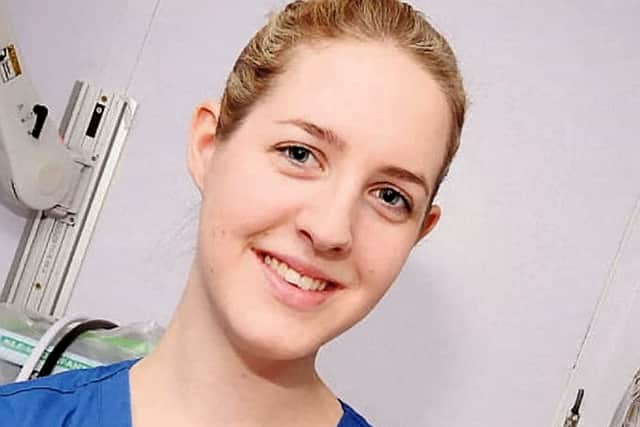Lucy Letby: murder trial told rigid wire could have caused baby’s ‘extraordinary bleeding’ - court latest
and live on Freeview channel 276
A rigid wire or tube may have been used to cause “extraordinary bleeding” in a baby boy allegedly murdered by nurse Lucy Letby, a court has heard. Jurors at Manchester Crown Court heard the infant lost a quarter of his blood volume before he collapsed and died in the Countess of Chester Hospital’s neo-natal unit.
The blood loss took place during a night shift on 3 August, 2015 in which Letby was the designated nurse for the premature-born twin boy, referred to as Child E. The Crown says Letby, 32, injected a fatal amount of air into the bloodstream of the youngster.
Advertisement
Hide AdAdvertisement
Hide AdLetby, originally from Hereford, denies the murders of seven babies and the attempted murders of 10 others between June 2015 and June 2016.
Giving evidence on Friday, expert medical witness Dr Dewi Evans said he thought Child E had suffered a fatal air embolism – a blockage of the blood supply – after a treating medic noticed “unusual” purple patches on the child’s abdomen.
He said a second “major” issue was “significant haemorrhaging from the upper gastrointestinal tract, somewhere between the mouth and the stomach”.
What was said during evidence about the child’s injuries?
Dr Evans said: “I think he (Child E) suffered trauma from some other form of injury and there were a number of bits of equipment on a neo-natal unit that are relatively rigid.
Advertisement
Hide AdAdvertisement
Hide Ad“Plastic tubes used for suction, for instance, so it could have been interference with that.” He said another medical instrument known as an introducer – a thin wire surrounded by plastic which can be used to intubate a baby – would be “more than sufficient to cause trauma if used inappropriately”.
Dr Evans said: “I cannot be 100 per cent certain what caused the trauma to the gastrointestinal system but it had to be some kind of relatively stiff (equipment) which was sufficient to cause this extraordinary bleeding.”


Prosecutor Nick Johnson KC asked the consultant paediatrician if there could be an “innocent explanation” for the level of bleeding. Dr Evans replied: “No. The other explanation for this is a bleeding ulcer. I have never seen a bleeding ulcer cause this sort of presentation.”
In his initial reports Dr Evans said he was “at a loss” to explain the haemorrhaging and it was not possible to say if any deliberate harm took place because of an absence of a post-mortem.
Advertisement
Hide AdAdvertisement
Hide AdIn a further report – after he reviewed a statement from Child E’s mother who described “horrendous crying” from her son and blood around his mouth – he suggested something “had been done or used” to cause trauma.
Dr Evans suggested that a nasogastric tube could have been thrust into the baby’s stomach with inappropriate force. However, he told the court he later saw the type of tube used by the hospital at the time and ruled out it could be capable of causing such damage.
Child E suffered a sudden deterioration from 11.40pm on 3 August, the court has heard, and later died early the next morning after staff were unable to resuscitate him. Dr Evans said, in his opinion, Child E was “stable” leading up to the beginning of the “massive” haemorrhaging during the night-shift.
Cross-examining, Ben Myers KC, defending, said: “The haemorrhaging that Child E experienced on August 3 and 4 could be due to some form of ulceration or bleeding from the stomach from natural causes, albeit not normal?” Dr Evans replied: “I don’t think so.”
Advertisement
Hide AdAdvertisement
Hide AdOn the expert’s initial belief a nasogastric tube could have been used to harm the child, Mr Myers said: ”You were looking for something that could possibly support an allegation of deliberate harm that you must have known was not realistic?”
Dr Evans said: “I disagree.” Mr Myers went on: “You are actively trying to find things that would support this allegation even when there is no evidential basis?”
The witness replied: “Child E had massive haemorrhaging from his upper gastrointestinal system and that is not something that occurs as a result of some kind of natural phenomenon.”
Fellow expert medical witness Dr Sandie Bohin agreed with Dr Evans that an air embolism was the cause of death. She added: “I have never seen a baby have a gastrointestinal haemorrhage in this way.
Advertisement
Hide AdAdvertisement
Hide Ad“I think the bleeding may have made him unstable but I don’t think that is what caused his death. I don’t think that is what caused him to collapse and need CPR.”
Mr Myers said: “He died because of a catastrophic bleed, didn’t he?” Dr Bohin replied: “I don’t believe that is so.” On Thursday Mr Myers suggested that medics were too slow during the night-shift to order an emergency blood transfusion for Child E. The trial continues on Monday.